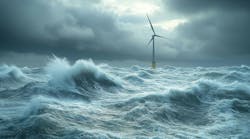China builds ‘record-breaking’ floating wind turbine
Chinese engineers have created a prototype floating wind turbine that they say has broken power generation records, according to a recent report on livescience.com and several other wire services.
This development, the report indicates, “could potentially usher in a new generation of renewable power generation.”
The turbine is the result of research by Chinese energy giant China Huaneng Group and power generator Dongfang Electric Corp., both of which are state-owned enterprises.
The turbine is said to be capable of generating 17 megawatts (MW) of electricity, or 68 million kilowatt hours (kWh) over the course of a year. Such performance could power the equivalent of 6,300 American households for a year, according to US Energy Information Administration data.
To generate this power, the nacelle—the central component within a wind turbine that contains the actual generator—sits atop a 489-ft-tall (152-m) tower, with blades that add up to a diameter of 860 ft (262 m).
Each “sweep,” or 360-degree rotation, of the blades encompasses an area of 53,000 sq m, or almost eight soccer fields’ worth.
Increasing the amount of electricity a single turbine can generate is important in encouraging greater adoption of wind power, since it reduces the overall number of turbines that have to be installed in each wind farm. This drives down the cost and reduces the time before turbines begin generating power.
Want more offshore wind content?
The monthly Renewable Energy newsletter provides updates on new technology, projects and policy for the development of offshore renewable energy from wind, waves, solar and other resources.
Subscribe for free today.
But the farther out to sea that the turbines are, the more extreme wind conditions they may be forced to withstand. China Huaneng Group has stated that the test turbine can endure waves in excess of 78 ft (24 m) high, as well as typhoon-speed winds—those in excess of 64 knots (73 miles per hour).
Later this year, the turbine will undergo testing off the coast of Yangjiang in southern China. If successful, the developers says that it could mark a breakthrough in offshore renewable energy by demonstrating that floating turbines can reliably generate large-scale electricity in deepwaters, where traditional fixed-bottom structures are not viable.
Dongfang Electric also tested a 26-MW fixed-bottom turbine in June 2025.
According to the Global Wind Energy Council, 80% of the world’s offshore wind generation potential is in water deeper than 195 ft (60 m), too deep for fixed-bottom turbines.
As the use of floating wind turbines expands, proponents say energy companies and nation states could potentially increase the amount of energy produced from wind by putting turbines in deeper waters.
Editor's note: This story is an update to "China tests ‘world’s largest’ offshore wind turbine," which was published by Offshore on June 3, 2025.
About the Author
Bruce Beaubouef
Managing Editor
Bruce Beaubouef is Managing Editor for Offshore magazine. In that capacity, he plans and oversees content for the magazine; writes features on technologies and trends for the magazine; writes news updates for the website; creates and moderates topical webinars; and creates videos that focus on offshore oil and gas and renewable energies. Beaubouef has been in the oil and gas trade media for 25 years, starting out as Editor of Hart’s Pipeline Digest in 1998. From there, he went on to serve as Associate Editor for Pipe Line and Gas Industry for Gulf Publishing for four years before rejoining Hart Publications as Editor of PipeLine and Gas Technology in 2003. He joined Offshore magazine as Managing Editor in 2010, at that time owned by PennWell Corp. Beaubouef earned his Ph.D. at the University of Houston in 1997, and his dissertation was published in book form by Texas A&M University Press in September 2007 as The Strategic Petroleum Reserve: U.S. Energy Security and Oil Politics, 1975-2005.


